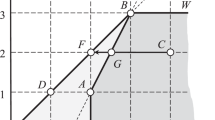Abstract
This paper re-assesses three independently developed approaches that are aimed at solving the problem of zero-weights or non-zero slacks in Data Envelopment Analysis (DEA). The methods are weights restricted, non-radial and extended facet DEA models. Weights restricted DEA models are dual to envelopment DEA models with restrictions on the dual variables (DEA weights) aimed at avoiding zero values for those weights; non-radial DEA models are envelopment models which avoid non-zero slacks in the input-output constraints. Finally, extended facet DEA models recognize that only projections on facets of full dimension correspond to well defined rates of substitution/transformation between all inputs/outputs which in turn correspond to non-zero weights in the multiplier version of the DEA model. We demonstrate how these methods are equivalent, not only in their aim but also in the solutions they yield. In addition, we show that the aforementioned methods modify the production frontier by extending existing facets or creating unobserved facets. Further we propose a new approach that uses weight restrictions to extend existing facets. This approach has some advantages in computational terms, because extended facet models normally make use of mixed integer programming models, which are computationally demanding.
Similar content being viewed by others
References
Ali, A.I. and L. M. Seiford (1993). “The Mathematical Programming Approach to Efficiency analysis.” In H.O. Fried, C.A.K. Lovell, and S.S. Schmidt (eds.), Oxford University Press, New York, Oxford. The Measurement of Productive Efficiency: Techniques and Applications. pp. 120–159.
Allen, R., A. Athanassopoulos, R.G. Dyson, and E. Thanassoulis (1997). “Weights Re-Strictions and Value Judgements in Data Envelopment Analysis: Evolution, Development and Future Directions.” Annals of perations Research, 73, 13–34.
Allen, R. and E. Thanassoulis (2004). “Improving Envelopment in data Envelopment Analy-sis.” European Journal of Operational Research, 154(2), 363–379.
Banker, R.D., A. Charnes, and W.W. Cooper (1984). “Some Models for Estimating Technical and Scale Inefficiencies in Data Envelopment Analysis.” Management Science, 30, 1078–1092.
Bessent, A., W. Bessent, J. Elam, and T. Clark (1988). “Efficiency Frontier Determination by Constrained Facet Analysis.” Journal of Operational Research Society, 36(5), 785–796.
Brockett, P.L., A. Charnes, W.W. Cooper, Z.M. Huang, and D.B. Sun (1997). “Data Transformations In DEA Cone Ratio Envelopment Approaches for Monitoring Bank Per-formances.” European Journal of Operational Research, 98, 250–268.
Charnes, A., W.W. Cooper, B. Golany, L. Seiford, and J. Stutz (1985). “Foundations of Data Envelopment Analysis for Pareto-Koopmans Efficient Empirical Production Functions.” Journal of Econometrics, 30, 91–107.
Charnes, A., W.W. Cooper, Z.M. Huang, and D.B. Sun (1990). “Polyhedral Cone-Ratio 30 DEA Models With an Illustrative Application to Large Industrial Banks.” Journal of Econometrics, 46, 73–91.
Charnes, A., W.W. Cooper, and E. Rhodes (1978). “Measuring Efficiency of Decision Making Units.” European Journal of Operational Research, 2, 429–444.
Charnes, A., W.W. Cooper, and R.M. Thrall (1986). “Classifying and Characterizing Efficiencies and Inefficiencies in Data Envelopment Analysis.” Operations Research Letters, 5(3), 105–110.
Cooper, W.W., K.S. Park, and J.T. Pastor (1999). “RAM: A Range Measure of Inefficiency for use with Additive Models, and Relations to Other Models and Measures in DEA.” Journal of Productivity Analysis, 11, 5–42.
Cooper, W.W. and K. Tone (1997). “Measures on Inefficiency in Data Envelopment Analysis and Stochastic Frontier Estimation.” European Journal of Operational Research, 99, 72– 88.
Färe, R. and C.A.K. Lovell (1978). “Measuring The Technical Efficiency of Production.” Journal of Economic Theory, 19(1), 150–162.
Green, R.H., J.R. Doyle, and W.D. Cook (1996). “Efficiency Bounds in Data Envelopment Analysis.” European Journal of Operational Research, 89, 482–490.
Lang, P., O.R. Yolalan, and O. Kettani (1995). “Controlled Envelopment by Face Extension in DEA.” Journal of Operational Research Society, 46(4), 473–491.
Olesen, O.B. and N.C. Petersen (1996). “Indicators of Ill-Conditioned Data Sets and Model Misspecication in Data Envelopment Analysis: An Extended Facet Approach.” Management Science, 42(2), 205–219.
Olesen, O.B. and N.C. Petersen (2003). “Identication and use of Efficient Faces and Facets in DEA.” Journal of Productivity Analysis, 20(3), 323–360.
Portela, M.C.S., P. Borges, and E. Thanassoulis (2003). “Finding Closest Targets in Non-oriented DEA Models: The Case of Convex and Non-Convex Technologies.” Journal of Productivity Analysis, 19(2/3), 251–269.
Portela, M.C.S. and E. Thanassoulis (2002). “Profit Efficiency in DEA.” Aston Busi-ness School Research Paper RP0206, ISBN 185449502X, University of Aston, Aston Triangle, Birmingham B4 7ET, UK.
Räty, T. (1998). “Efficient facets, Influential Observations and Revisions of The Best Practice Boundary for DEA.” Ph.D. thesis, University of Joensuu.
Räty, T. (2002). “Efficient Facet Based Efficiency Index: A Variable Returns to Scale Specification.” Journal of Productivity Analysis, 17(1/2), 65–82.
Thanassoulis, E. and R. Allen (1998). “Simulating Weights Restrictions in data Envelopment Analysis by Means of Unibserved DMUs.” Management Science, 44(4), 586–594.
Thanassoulis, E. and R. Dyson (1992). “Estimating Preferred Input-output Levels Using Data Envelopment Analysis.” European Journal of the Operational Research Society, 56, 80–97.
Thanassoulis, E., M.C.S. Portela, and R. Allen (2004). “Incorporating Value Judgments in DEA.” In W. W. Cooper, L. W. Seiford, and J. Zhu (eds.), Handbook on Data Envelopment Analysis. Kluwer Academic Publishers.
Thompson, R., L. Langemeier, C. Lee, E. Lee, and R.M. Thrall (1990). “The Role of Multiplier Boundas in Efficiency Analysis with Application to Kansas Farming.” Journal of Econometrics, 46, 93–108.
Thompson, R.G., P.S. Dharmapala, and R.M. Thrall (1995). “Linked-cone DEA Profitratios and Technical Efficiency with Application to Illinois Coal Mines.” International Journal of Production Economics, 39, 99–115.
Thompson, R.G., J.F.D. Singleton, R.M. Thrall, and B.A. Smith (1986). “Comparative Site Evaluations for Locating a High-energy Physics Lab in Texas.” Interfaces, 16, 35–49.
Tone, K. (1993). “An e-free DEA and a new measure of Efficiency.” Journal of the Opera-Tions Research Society of Japan, 36(3), 167–174.
Tone, K. (2001). “A Slacks-Based Measure of Efficiency in Data Envelopment Analsysis.” European Journal of Operational Research, 130, 498–509.
Zhu, J. (1996). “Data Envelopment Analysis with Preference Structure.” Journal of the Operational Research Society, 47, 136–150.
Author information
Authors and Affiliations
Corresponding author
Rights and permissions
About this article
Cite this article
Portela, M.C.A.S., Thanassoulis, E. Zero weights and non-zero slacks: Different solutions to the same problem. Ann Oper Res 145, 129–147 (2006). https://doi.org/10.1007/s10479-006-0029-4
Published:
Issue Date:
DOI: https://doi.org/10.1007/s10479-006-0029-4




